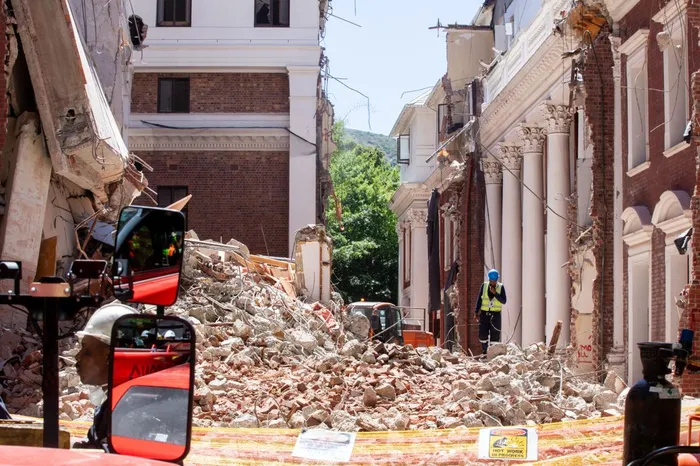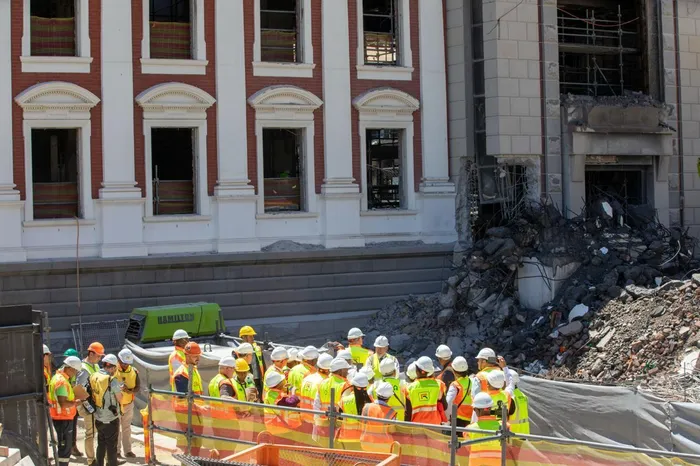Progress report on Parliament restoration shows promise despite cost concerns
POLITICAL LANDMARK

The Joint Standing Committee on the Financial Management of Parliament (JSCFMP), along with members from the Portfolio and Select Committees on Public Works and Infrastructure, conduct an inspection of the Rebuilding of Parliament project.
Image: Zwelethemba Kostile/Parliament
Three years after a devastating blaze swept through Parliament's National Assembly and Old Assembly, Members of Parliament (MPs) gathered recently for a crucial update on the anticipated restoration of the severely damaged structures. Their tour of the ongoing construction site served as an informative walkabout, highlighting the significant strides made towards reviving one of South Africa's most important political landmarks.
The Development Bank of Southern Africa (DBSA), appointed to oversee the restoration, provided the Joint Standing Committee on Financial Management of Parliament with an in-depth overview of the project’s current status. As the implementing partner, the DBSA's presentation was met with commendation from committee members, who described it as inspiring and illuminating.
During a detailed briefing, special project manager Simon Mashigo outlined the expected completion dates for the reconstruction. The National Assembly is projected to be ready by November 2026, while the Old Assembly is set to be completed by December 2026, with practical completion planned for February 2027, a timeframe designed to ensure that the buildings are prepared for their intended use. Mashigo affirmed that the project is progressing well, adhering to clear baselines and sustainable design principles, promising a modern, climate-resilient, and technologically integrated precinct by the end of November 2026.
However, some committee members expressed concerns regarding inconsistencies in the reported completion timelines, questioning the multiple dates of November and December 2026. They also sought greater clarity on the increasing costs associated with the restoration, noting that the overall budget has ballooned from R2.2 billion in 2024 to an estimated R4.6 billion today.
In response, Mashigo explained that the budget of R4.6 billion encompasses the entire infrastructure programme and is divided into five main work packages, including three specific packages dedicated to the National Assembly rebuild. He reassured MPs that no cost overruns have occurred, with all contracts operating within the approved fiscal parameters. As of September, R1,036 billion has already been spent on the project, leaving a remaining budget of R3,346 billion.

The Joint Standing Committee on the Financial Management of Parliament (JSCFMP), and members of the Portfolio and Select Committees on Public Works & Infrastructure, examine the rubble at the Rebuilding of Parliament project.
Image: Zwelethemba Kostile/Parliament
Despite acknowledging the increased budget, MPs pressed for a detailed breakdown of expenditure — including whether design changes or inflation were contributing factors to the cost variance. The DBSA has committed to providing a comprehensive schedule, budget breakdown, and necessary approval documents ahead of their next briefing, in response to these requests.
The co-chairperson of the committee, Sanny Ndhlovu, welcomed the positive updates from the DBSA while stressing the committee’s readiness to exercise its oversight duties throughout the reconstruction process. “As a committee, we welcome the progress and work done and wish them well in their efforts. We stand ready to ensure that the reconstruction of Parliament is completed on time, within budget, and to the highest standards of safety, sustainability, and accountability,” Ndhlovu stated.